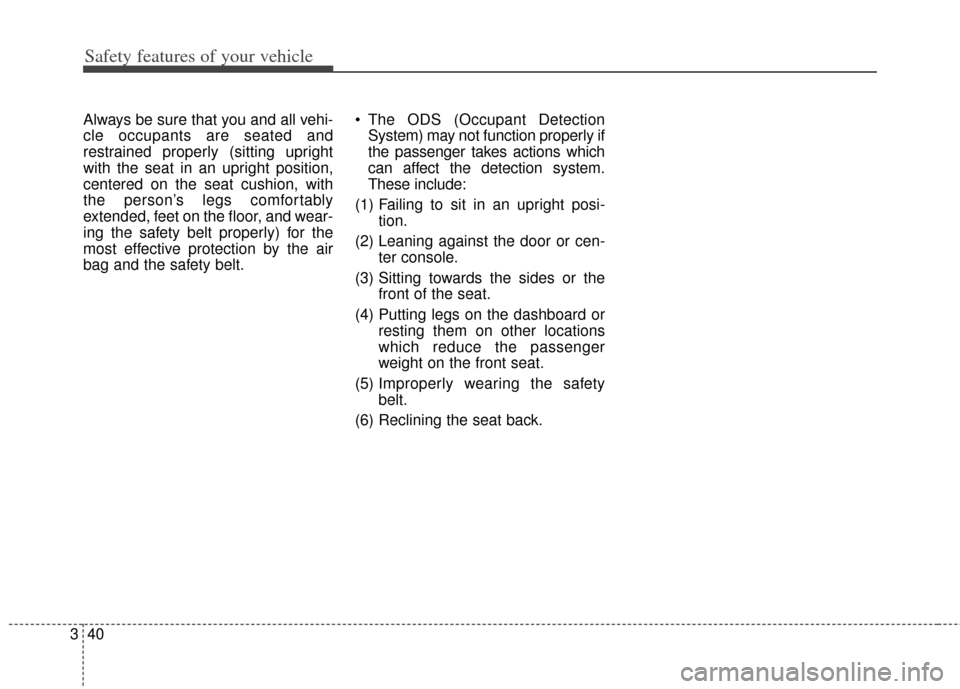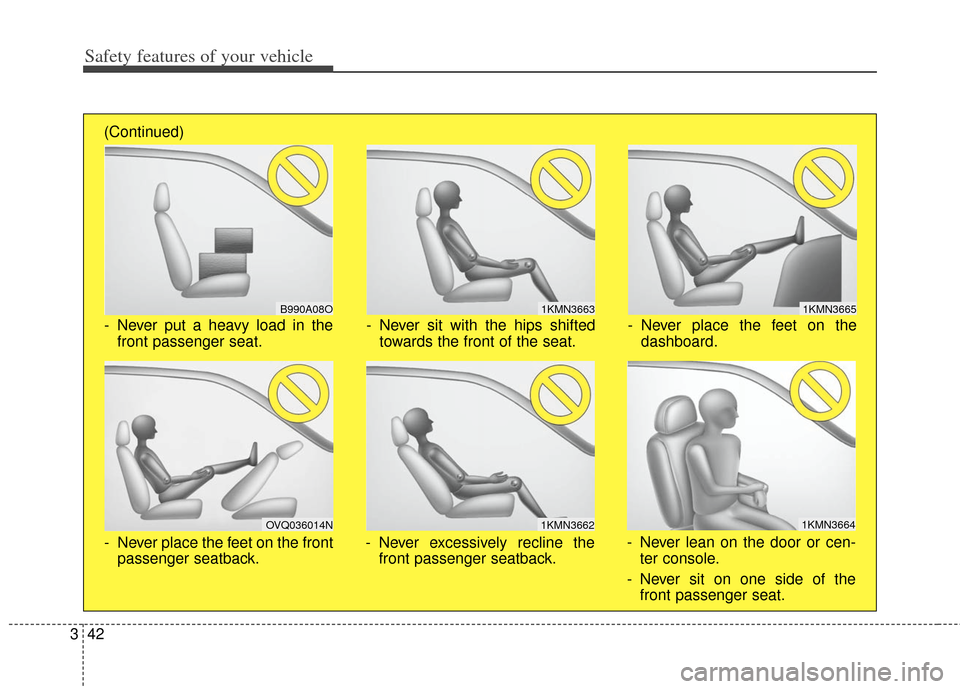2012 KIA Soul tow
[x] Cancel search: towPage 12 of 393

I9
Index
Tires and wheels ··················\
··················\
·················7-41\
, 8-3Checking tire inflation pressure ··················\
··············7-42
Compact spare tire replacement ··················\
··············7-45
Recommended cold tire inflation pressures ··············7-41
Tire care··················\
··················\
··················\
···············7-41
Tire maintenance ··················\
··················\
··················\
·7-46
Tire replacement ··················\
··················\
··················\
··7-45
Tire rotation ··················\
··················\
··················\
·········7-43
Tire sidewall labeling ··················\
··················\
············7-46
Tire traction ··················\
··················\
··················\
·········7-46
Wheel alignment and tire balance ··················\
···········7-44
Wheel replacement ··················\
··················\
················7-46
Towing ··················\
··················\
··················\
··················\
···6-27
Towing capacity ··················\
··················\
··················\
·······5-53
Transaxle Automatic transaxle ··················\
··················\
··············5-20
Manual transaxle ··················\
··················\
··················\
·5-17
Trip computer ··················\
··················\
··················\
··········4-44 Vehicle break-in process ··················\
··················\
··············1-5
Vehicle capacity weight ··················\
··················\
·············5-52
Vehicle certification label ··················\
··················\
············8-7
Vehicle curb weight ··················\
··················\
··················\
·5-57
Vehicle handling instruncions··················\
··················\
······1-5
Vehicle identification number (VIN) ··················\
·············8-7
Vehicle load limit ··················\
··················\
··················\
·····5-52
Cargo capacity ··················\
··················\
··················\
·····5-53
Certification label ··················\
··················\
··················\
5-55
Seating capacity ··················\
··················\
··················\
··5-52
Steps For Determining Correct Load Limit ··············5-53
Tire and loading information label··················\
··········5-52
Towing capacity ··················\
··················\
··················\
··5-53
Vehicle capacity weight ··················\
··················\
········5-52
Vehicle stability management ··················\
··················\
····5-34
Vehicle weight ··················\
··················\
··················\
·········5-57 Base curb weight ··················\
··················\
··················\
·5-57
Cargo weight ··················\
··················\
··················\
·······5-57
GAW (Gross axle weight) ··················\
··················\
·····5-57
GAWR (Gross axle weight rating)··················\
··········5-57
GVW (Gross vehicle weight)··················\
··················\
5-57
GVWR (Gross vehicle weight rating) ··················\
····5-57
Vehicle curb weight··················\
··················\
···············5-57
Volume/weight ··················\
··················\
··················\
···········8-3V
Page 18 of 393

15
Introduction
Operation in foreign countries
If you are going to drive your vehicle
in another country, be sure to:
Observe all regulations regardingregistration and insurance.
Determine that acceptable fuel is available. As with other vehicles of this type,
failure to operate this vehicle cor-
rectly may result in loss of control,
an accident or vehicle rollover.
Specific design characteristics (high-
er ground clearance, track, etc.) give
this vehicle a higher center of gravity
than other types of vehicles. It is not
designed for cornering at the same
speeds as a conventional 2-wheel
drive sedans or sports coupe. Avoid
sharp turns or abrupt maneuvers.
Failure to operate this vehicle cor-
rectly may result in loss of control, an
accident or vehicle rollover.
Be sure
to read the “Reducing the risk of a
rollover” driving guidelines, in
section 5 of this manual. No special break-in period is need-
ed. By following a few simple precau-
tions for the first 1,000 km (600
miles) you may add to the perform-
ance, economy and life of your vehi-
cle.
Do not race the engine.
While driving, keep your engine
speed (rpm, or revolutions per
minute) between 2,000 rpm and
4,000 rpm.
Do not maintain a single speed for long periods of time, either fast or
slow. Varying engine speed is
needed to properly break-in the
engine.
Avoid hard stops, except in emer- gencies, to allow the brakes to seat
properly.
Don't let the engine idle longer than 3 minutes at one time.
Don't tow a trailer during the first 2,000 km (1,200 miles) of opera-
tion.
VEHICLE BREAK-IN
PROCESS
VEHICLE HANDLING
INSTRUCTIONS
Page 34 of 393

311
Safety features of your vehicle
To fold down the rear seatback:
1. Insert the rear seat belt buckle inthe pocket (if equipped) between
the rear seatback and cushion,
and insert the rear seat belt web-
bing in the guide to prevent the
seat belt from being damaged.
2. Set the front seatback to the upright position and if necessary,
slide the front seat forward.
3.Lower the rear headrests to the lowest position. 4.Pull on the seatback folding lever,
then fold the seat toward the front
of the vehicle. When you return the
seatback to its upright position,
always be sure it has locked into
position by pushing on the top of
the seatback. 5. To use the rear seat, lift and pull
the seatback backward by pulling
on the folding lever. Pull the seat-
back firmly until it clicks into place.
Make sure the seatback is locked
in place.
6. Return the rear seat belt to the proper position.
When returning the rear seatbacks to
the upright position, remember to
return the rear shoulder belts to their
proper position.
OAM039020
OAM039021
OAM039022OAM032025N
Page 41 of 393

Safety features of your vehicle
18
3
When using the rear center seat belt,
the buckle with the “CENTER” mark
must be used. To release the seat belt:
The seat belt is released by pressing
the release button (1) in the locking
buckle. When it is released, the belt
should automatically draw back into
the retractor.
If this does not happen, check the
belt to be sure it is not twisted, then
try again.Stowing the rear seat belt
The rear seat belt buckles can be
stowed in the pocket between the
rear seatback and cushion when not
in use.
OAM039046OAM039047B210A01NF-1
Page 63 of 393

Safety features of your vehicle
40
3
Always be sure that you and all vehi-
cle occupants are seated and
restrained properly (sitting upright
with the seat in an upright position,
centered on the seat cushion, with
the person’s legs comfortably
extended, feet on the floor, and wear-
ing the safety belt properly) for the
most effective protection by the air
bag and the safety belt. The ODS (Occupant Detection
System) may not function properly if
the passenger takes actions which
can affect the detection system.
These include:
(1) Failing to sit in an upright posi- tion.
(2) Leaning against the door or cen- ter console.
(3) Sitting towards the sides or the front of the seat.
(4) Putting legs on the dashboard or resting them on other locations
which reduce the passenger
weight on the front seat.
(5) Improperly wearing the safety
belt.
(6) Reclining the seat back.
Page 65 of 393

Safety features of your vehicle
42
3
1KMN3663
1KMN3664
1KMN3665
- Never sit with the hips shifted
towards the front of the seat.
- Never lean on the door or cen-ter console.
- Never sit on one side of the front passenger seat.
- Never place the feet on the
dashboard.
B990A08O
1KMN3662
- Never put a heavy load in thefront passenger seat.
- Never excessively recline thefront passenger seatback.
OVQ036014N
- Never place the feet on the frontpassenger seatback.
(Continued)
Page 91 of 393

Features of your vehicle
12
4
Panic
1.Press the panic button(4) for more
than 0.5 second.
2.The horn sounds and hazard warn- ing light flash for about 30 sec-
onds.
To stop the horn and lights, press
any button on the smart key.
Start-up
You can start the engine without
inserting the key. For detailed infor-
mation refer to the “Engine start/stop
button” in section 5.
Loss of the smart key
A maximum of 2 smart keys can be
registered to a single vehicle.
If you happen to lose your smart key,
you will not be able to start the
engine. You should immediately take
the vehicle and remaining key to your
authorized Kia dealer(tow the vehi-
cle, if necessary) to protect it from
potential theft.
Smart key precautions
The smart key will not work if any of the following occur:
- The smart key is close to a radio transmitter such as a radio sta-
tion or an airport which can inter-
fere with normal operation of the
smart key.
- The smart key is near a mobile two way radio system or a cellu-
lar phone.
- Another vehicle’s smart key is being operated close to your
vehicle.
When the smart key does not work correctly, open and close the door
with the mechanical key and con-
tact an authorized Kia dealer.
CAUTION - Smart key
Keep the smart key away fromwater or any liquid as it canbecome damaged and not func-tion properly. If the smart key isinoperative due to exposure towater or liquids, it will not becovered by your manufacturer'svehicle warranty.
Page 92 of 393

413
Features of your vehicle
Door lock/unlock in an emer-
gency situation
If the smart key does not operate
normally, you can lock or unlock the
doors by using the mechanical key.
1.Press and hold the release button(1) and remove the mechanical key
(2).
2.Insert the key into the hole of the outside door handle. Turn the key
toward the rear of the vehicle to
lock and toward the front of the
vehicle to unlock.
3. To reinstall the mechanical key, put the key into the hole and push
it until a click sound is heard.
Smart key immobilizer system
Your vehicle is equipped with an elec-
tronic engine immobilizer system to
reduce the risk of unauthorized vehi-
cle use.
Your immobilizer system is com-
prised of a small transponder in the
smart key and electronic devices
inside the vehicle.
With the immobilizer system, when-
ever you turn the engine start/stop
button to the ON position by pressing
the button while carrying the smart
key, it checks and determines and
verifies if the smart key is valid or
not.
If the key is determined to be valid,
the engine will start.
If the key is determined to be invalid,
the engine will not start.
To deactivate the immobilizer
system:
Turn the engine start/stop button to
the ON position by pressing the but-
ton while carrying the smart key.
To activate the immobilizer sys-tem:
Turn the engine start/stop button to
the OFF position. The immobilizer
system activates automatically.
Without a valid smart key for your
vehicle, the engine will not start.
OEN040002K